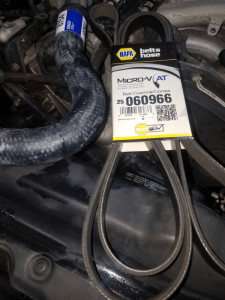
On some engines, the water pump is driven by the timing belt as opposed to the serpentine belt. If that’s the case, it’s a good idea to replace the water pump when you’re replacing the timing belt and vice versa, since much of the same work has to be done for either. The same is true for the timing belt tensioner – it should be inspected and possibly replaced. Now, replacing a one of these belts can be one of the more expensive routine maintenance items on your service schedule. But having these belts break can be catastrophic to your engine AND cost you damages internally to your engine and to other parts that are connected.
Hoses serve a pretty obvious purpose on the vehicle; they transport liquids where they need to go, whether it is water to cool the engine, brake fluid to stop you, or any other purpose. They do get old and squishy and the cooling system will run a pressure of 15 to 20 PSI and can blow a hole on the old hose. It is more common for vehicles to have hoses with plastic fittings, elbows, and T’s, which get old and brittle and crack. As well as the quick disconnects that are used during assembly at the factory have plastic clips in them that get old and start to leak.
As with belts, the quality of hoses has increased over the years, but we do still see failures. Regular inspections of the hoses for leaks, cracks, or other signs of wear are very important to your vehicle’s future.
A pulley attached to the engine’s crank provides the power to turn the serpentine belt. This belt may provide the power for the power steering pump, the alternator, the air conditioning compressor and many more things on some vehicles. No matter what is driven by this belt, you are not going to get far without it or the tensioner pulley that keeps it running at the correct tension. A worn serpentine belt may be hard to spot. Newer and tougher belt material is coming out all the time, and now a worn belt may not show frayed edges or chunks falling off but damage is still being done to rotating parts that need this belt to be in top shape. Luckily, at Jammin’ J Auto we attend regular training on what to look for and have gauges on hand to measure the thickness and tension of the belt to determine if a belt is in need of replacing. Manufacturers have recommendations for each vehicle as well as to what intervals this belt (and the tensioner) should be replaced.
Another major belt in your vehicle is the timing belt. It synchronizes the timing of your combustion process. Your pistons travel up and down in the cylinder. Intake valves open at the right time to let in air and fuel; they close at the right time to allow the fuel to burn and then the exhaust valves open at the right time to let out the exhaust. All this happens thousands of times a minute and it’s your timing belt that makes sure the valves are opening and closing at precisely the right time. If the timing is off, your engine won’t run. And that’s the best case. The worst case is that a valve is opening at the wrong time and collides with the piston. The result is bent valves and maybe even more damage to the cylinder head. Repairs can run several thousand dollars. Now, timing belts just wear out naturally so you want to replace a worn belt before it slips or breaks. If you’ve never replaced your timing belt and have more than 60,000 miles on your vehicle, talk with your service advisor at Jammin’ J Automotive right away to put together a maintenance plan.
These items and more are things that we will observe and make recommendations based on not only what the manufacturer says, but also on what we see when we work on your car on a regular basis. Regular and timely multi-point inspections can help guide you to put together a preventative maintenance plan to keep your vehicle running.
